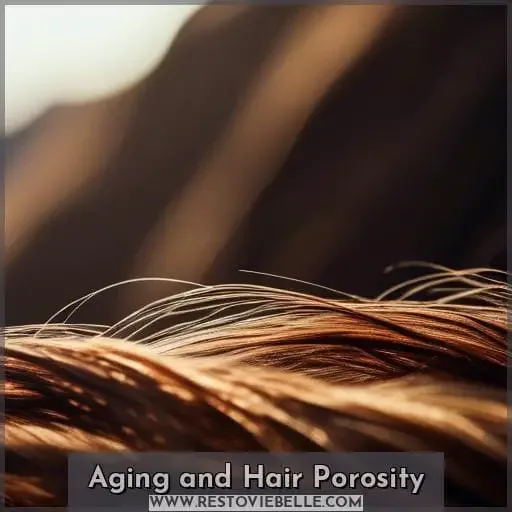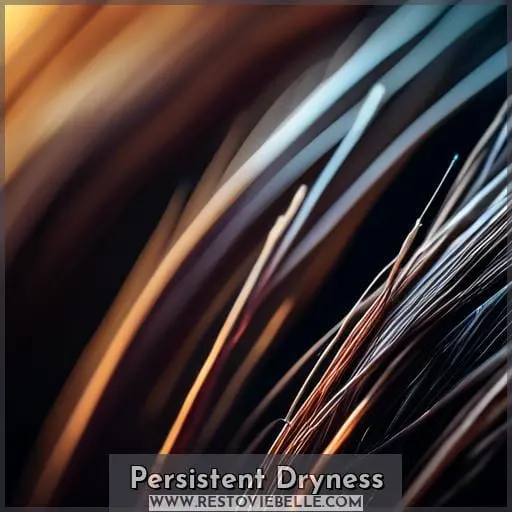This site is supported by our readers. We may earn a commission, at no cost to you, if you purchase through links.
 Like a sponge that can’t seem to hold water, your hair dries rapidly, leaving you puzzled and seeking answers. If you’re grappling with strands that transition from wet to dry faster than you can finish your coffee, you might be dealing with high porosity hair.
Like a sponge that can’t seem to hold water, your hair dries rapidly, leaving you puzzled and seeking answers. If you’re grappling with strands that transition from wet to dry faster than you can finish your coffee, you might be dealing with high porosity hair.
This article delves into the reasons behind this quick-drying phenomenon, from environmental factors to the very structure of your hair. Understanding the why is the first step to mastering your hair’s health and embracing the freedom that comes with that knowledge.
Let’s unravel the mystery of why your hair dries so fast and what it reveals about your hair’s needs.
If your hair dries quickly, it could be due to low humidity, your hair type, or the products you use, which isn’t necessarily bad. High porosity, which allows hair to absorb and lose moisture rapidly, is another common reason for fast-drying hair.
Table Of Contents
- Key Takeaways
- Aging and Hair Porosity
- Rough Hair Texture
- Shine and Hair Health
- Persistent Dryness
- Brittle Hair
- Quick Drying Post-Wash
- Frizz and Humidity
- Tangle-Prone Hair
- Elasticity Loss
- Curly Hair Characteristics
- Frequently Asked Questions (FAQs)
- How does the water quality in my area affect the porosity of my hair?
- Can dietary changes impact the porosity level of my hair?
- How does the frequency of trimming hair influence its porosity?
- Are there any specific vitamins or minerals known to improve the health of high porosity hair?
- How do seasonal changes, like winter dryness or summer humidity, affect the management of high porosity hair?
- Conclusion
Key Takeaways
- High porosity hair dries quickly after washing due to its porous nature, which allows water to enter and escape the hair shaft easily.
- Environmental factors such as UV exposure and pollution, chemical treatments like bleaching and coloring, and genetic factors can contribute to high hair porosity.
- High porosity hair often experiences challenges like frizz, tangles, and elasticity loss, which are exacerbated by factors like hard water and seasonal changes.
- To manage high porosity hair, it is recommended to use sealing oils, cold water rinses, and regular deep conditioning, while avoiding overwashing and over-conditioning.
Aging and Hair Porosity
As you age, you might notice your hair drying faster than it used to. This can be a sign of increased porosity. The change is often due to a combination of environmental factors, such as UV exposure and pollution, and the natural aging process.
To manage these changes, it’s important to protect your hair from damage and maintain its moisture balance.
Environmental and Styling Tool Impact
As you age, your hair’s battle with the elements and styling tools can lead to increased porosity. This means your hair may absorb moisture quickly but struggle to retain it, leading to dryness and damage.
Bleaching and coloring further exacerbate this issue, as they can strip hair of its natural protection. Genetics also play a role, with certain hair textures naturally more porous than others.
Understanding your hair’s porosity is crucial for maintaining its health and selecting the right products to manage moisture levels effectively.
Hormonal Changes and Aging
As you age, particularly through menopause, your hair undergoes significant changes, often becoming more porous. This shift is largely due to hormonal imbalances, including a decrease in estrogen levels, which can lead to thinner, drier, and more brittle hair.
Menopause’s impact on hair porosity is profound, as the hormonal changes can alter hair texture, increase hair breakage, and affect hair type. To manage these changes, it’s crucial to adopt hair porosity treatments that cater to your evolving hair needs.
Incorporating moisture-sealing products and avoiding harsh chemicals can help maintain your hair’s health during this transition. Understanding these changes allows for better care strategies, ensuring your hair remains as vibrant and resilient as possible despite hormonal challenges.
Rough Hair Texture
If you’re grappling with a rough hair texture, it’s likely due to lifted hair cuticles, which can be a sign of high porosity. This condition means your hair cuticles are raised, allowing moisture to escape and making your strands more susceptible to damage.
High porosity can stem from various factors, including environmental exposure, chemical treatments like bleaches and dyes, and even genetics. Aging and hormonal changes, particularly during and after menopause, can also contribute to increased hair porosity.
For those with curly hair, you might find that your hair is naturally more porous. This inherent trait can make your curls prone to dryness and breakage despite your best hair care efforts. To manage this, it’s crucial to adapt your hair care routine to include products that help seal in moisture and protect your hair from further damage.
Look for moisturizing hair products and consider using heat protection when styling. Additionally, avoid overwashing and over-conditioning to prevent moisture overload, which can lead to brittle hair.
Incorporating product recommendations and styling tips that cater to high porosity hair can make a significant difference. For instance, using sealing oils, shea, coconut, and mango butters can be beneficial.
Cold water rinses can help close the cuticles, and regular deep conditioning with a balance of protein and moisture is recommended to maintain hair health. Remember, understanding your hair’s porosity is key to tailoring your hair care routine effectively.
Shine and Hair Health
Continuing from the challenges of rough hair texture, let’s delve into the crucial aspect of shine and hair health. The luster of your hair isn’t just about aesthetics; it’s a telling sign of its overall condition.
- Pre-wash Treatments: Begin with nourishing oils or masks to protect and fortify your strands before shampooing.
- Protein Treatments and Moisture Balancing Products: These are essential for repairing damaged cuticles and maintaining the delicate hair protein and moisture balance, crucial for hair health.
- Assess Hair Porosity: Understanding your hair’s porosity can guide you in choosing the right products and heat styling techniques, ensuring you don’t exacerbate dryness or damage.
Incorporating these practices into your routine can significantly improve your hair’s shine, reflecting a healthier, more vibrant state.
Persistent Dryness
Continuing from the previous discussion on lack of shine, let’s delve into the frustrating issue of persistent dryness.
Despite your best efforts to moisturize, you might find your hair still feels parched. This can be a telltale sign of high porosity hair, where the cuticles are lifted or damaged, allowing moisture to escape as quickly as it’s absorbed.
This characteristic of high porosity hair can leave your strands thirsty, leading to a rough texture and making them prone to tangles and frizz. It’s a cycle that can seem endless, but understanding hair porosity is key to breaking it.
By recognizing these hair porosity characteristics, you can tailor your hair care routine to include products that not only hydrate but also seal in that much-needed moisture. Remember, brittle hair and quick drying are challenges, but with the right approach, you can nurture your hair back to health.
Brittle Hair
While persistent dryness can leave your hair thirsting for moisture, an equally frustrating concern is brittle hair, which often signals a deeper imbalance. Brittle strands may indicate that your hair is struggling with moisture retention, lacking in protein balance, or suffering from improper product absorption.
These issues can lead to a host of unwelcome hair woes, from split ends to a lack of elasticity, making styling a delicate task.
- Moisture retention is key; without it, your hair becomes as fragile as autumn leaves, ready to break at the slightest touch.
- A harmonious protein balance is essential for strength, warding off the specter of split ends and breakage.
- Thoughtful styling considerations and choosing the right products can help manage hair porosity, keeping frizz at bay and maintaining the integrity of each strand.
Understanding your hair’s porosity through a simple hair porosity test or referring to a hair porosity chart can guide you to the right hair care regimen, ensuring your locks remain resilient and vibrant.
Quick Drying Post-Wash
If you’ve noticed your hair drying unusually fast after washing, it could be a sign of high porosity. High porosity hair has a raised cuticle layer that easily absorbs water but also releases it just as quickly, leading to fast-drying hair.
This characteristic often results from environmental damage, chemical treatments, or genetic factors. To manage this, you might want to incorporate frizz control techniques and moisture retention strategies into your hair care routine.
Using styling products designed for high porosity hair can help, as well as applying hair masks regularly to nourish and repair the hair. These products work by sealing the cuticle, reducing moisture loss, and protecting the hair from further damage.
It’s also important to understand that while high porosity hair can absorb moisture easily, it struggles to retain it, which is why your hair dries so fast.
To combat this, look for products that specifically address hair porosity issues, whether your hair porosity is high or medium. By doing so, you can improve your hair’s ability to hold onto moisture, leading to healthier, more manageable locks.
Remember, the goal isn’t just to add moisture but to keep it sealed within the hair strands.
Frizz and Humidity
When you’re dealing with frizz and humidity, it’s often a sign that your hair’s cuticle layer is compromised, leading to high porosity. This means your hair absorbs moisture quickly but struggles to retain it, causing the cuticle to lift and create a frizzy texture.
To manage this, focus on frizz management and humidity control. Start by using a hydrating shampoo and a leave-in conditioner to replenish moisture without weighing down your hair. These products help to smooth the cuticles and provide a barrier against humidity.
Additionally, consider using hair oils or serums that can seal in moisture and protect against cuticle damage. Remember, maintaining hair volume without frizz is a delicate balance, especially in humid conditions.
By understanding your hair’s porosity, you can select products that help retain the right amount of moisture, keeping your hair healthy and more manageable.
Tangle-Prone Hair
Continuing from the challenges of frizz, another common struggle for those with high porosity hair is its tendency to become tangle-prone. This is due to the rough texture and lifted cuticles that can cause individual strands to catch on each other, leading to knots and tangles.
If you’re experiencing hair breakage, hair thinning, split ends, or scalp irritation, it could be a sign that your hair’s porosity is contributing to these issues.
High porosity hair, which includes many curly hair types, absorbs moisture quickly but also loses it just as fast, making it thirsty for hydration. However, too much moisture without proper sealing can lead to further brittleness.
To manage this, it’s crucial to follow hair porosity tips that cater specifically to your hair’s needs. For instance, using products designed for high porosity hair can help mitigate tangle formation and reduce breakage.
Elasticity Loss
Loss of hair elasticity can be a telltale sign that your locks are craving more attention. It’s a reflection of the health of your hair, indicating a potential imbalance in moisture and protein, or the impact of external stressors.
-
Hair Growth and Scalp Health: Elasticity is crucial for preventing breakage, which can impede hair growth. A healthy scalp is the foundation for strong hair, so nurturing it can improve elasticity.
-
Nutrient Deficiency: Your hair’s resilience can be compromised by a lack of nutrients. Ensuring a diet rich in proteins, vitamins, and minerals supports the structural integrity of your hair.
-
Product Selection: Choosing the right products is essential. Look for those that balance moisture and protein, and avoid harsh chemicals that can strip your hair of its natural elasticity.
Curly Hair Characteristics
Curly hair, often naturally high porosity, presents unique challenges like increased moisture loss and susceptibility to breakage. The distinctive texture of curly hair, with its coiled structure, can lead to more significant moisture evaporation, making it prone to dryness and frizz.
Managing curly hair requires specialized products that cater to its high porosity needs, such as deep conditioning treatments and sealing oils. To combat breakage and maintain healthy curls, incorporating moisture-rich products is essential.
Understanding the intricacies of high porosity hair texture is crucial for selecting the right products that effectively address moisture retention and prevent excessive dryness and breakage.
Frequently Asked Questions (FAQs)
How does the water quality in my area affect the porosity of my hair?
Hard water, with its high mineral content, can significantly affect your hair’s porosity by depositing minerals like calcium and magnesium onto your hair shaft.
This buildup can lead to increased hair porosity, making your hair more prone to dryness, damage, and breakage.
Essentially, the minerals in hard water can create a barrier that prevents moisture from penetrating your hair effectively, exacerbating issues related to high porosity hair.
Can dietary changes impact the porosity level of my hair?
Dietary changes can indeed impact your hair’s porosity.
A balanced intake of proteins, vitamins, and minerals is crucial for maintaining healthy hair.
How does the frequency of trimming hair influence its porosity?
While you might not see the connection at first, regular trims can actually help manage your hair’s porosity.
By cutting away split ends and preventing them from traveling up the hair shaft, trims keep your hair healthier and less porous.
Are there any specific vitamins or minerals known to improve the health of high porosity hair?
For high porosity hair, vitamins and minerals like biotin, vitamins C, D, E, zinc, and iron are crucial. They support scalp health, stimulate hair growth, and improve hair’s structural integrity.
Incorporating a balanced diet or supplements can help bridge nutritional gaps, ensuring your hair receives the nourishment it needs to thrive.
How do seasonal changes, like winter dryness or summer humidity, affect the management of high porosity hair?
In winter, your high porosity hair is more vulnerable to dryness and breakage due to the cold, which strips moisture.
Summer’s humidity can cause frizz and further moisture loss, necessitating protective styling and hydration-focused care.
Conclusion
So, you’ve discovered your hair dries faster than a desert under the midday sun—welcome to the high porosity club! It’s a place where moisture checks in but doesn’t stick around for long.
But don’t fret; this just means your hair is eager to embrace the world, albeit a bit too enthusiastically. Remember, your quick-drying locks are a sign to pay extra attention to hydration and protection.
Embrace your hair’s unique needs, and you’ll turn what seems like a curse into your crowning glory. Keep nurturing your hair, and it’ll thank you by revealing its true, vibrant potential.
Why does your hair dry so fast? It’s not just a quirk—it’s a call to action for tailored care.
















